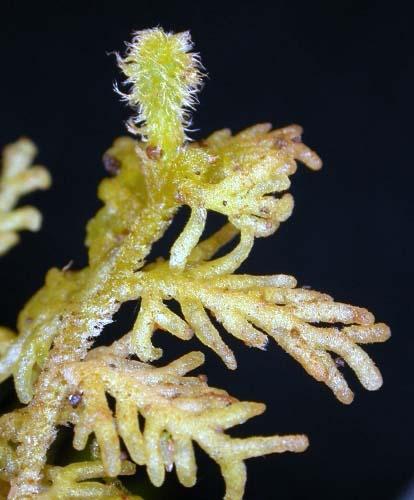
30-Stephaniella-paraphyllina-JB-Jack-21-22-Paraphyllia-of-the-stem-23-Female.png from: https://www.researchgate.net/figure/30-Stephaniella-paraphyllina-JB-Jack-21-22-Paraphyllia-of-the-stem-23-Female_fig4_312598877
Trichocolea paraphyllina: The Fascinating Feathery Moss
Introduction
Trichocolea paraphyllina (Spruce) Steph., also known simply as Trichocolea, is a captivating species of moss belonging to the Trichocoleaceae family. This delicate and intricate moss has garnered attention from enthusiasts and researchers alike for its unique morphology and ecological adaptations. In this blog post, we will dive into the fascinating world of Trichocolea paraphyllina and explore its distinguishing features, global distribution, habitat preferences, and ecological roles.

medium.jpeg from: https://enciclovida.mx/especies/137072-trichocolea
Background
Trichocolea paraphyllina is a member of the Marchantiophyta, the division of non-vascular land plants commonly known as liverworts and mosses. It belongs to the class

Close-up-of-Trichocolea-tomentella-at-one-of-the-localities-in-Hordaland-Bergen-Photo.png from: https://www.researchgate.net/figure/260186911_fig1_Figure-1-Close-up-of-Trichocolea-tomentella-at-one-of-the-localities-in-Hordaland
Jungermanniopsida, which encompasses leafy liverworts. The genus Trichocolea is known for its feathery appearance, with the specific epithet “paraphyllina” referring to the presence of paraphyllia, small leaf-like structures, on the stems.
Morphology and Identification
One of the most striking features of Trichocolea paraphyllina is its delicate, feathery appearance. The moss forms dense, pale green to yellowish-green mats or cushions. The stems are pinnately branched and covered in numerous, finely divided leaves and paraphyllia. The leaves are deeply divided into narrow, hair-like segments, giving the moss a plumose or feathery look.

bab0e98551f7bd4616b7db55ddf7fe3d.jpg from: https://www.pinterest.com/pin/trichocolea-tomentella–308637380693938907/
Identifying Trichocolea paraphyllina requires careful observation of its microscopic features. The leaf cells are thin-walled and lack trigones, which are thickenings at the cell corners. The underleaves, or amphigastria, are similar in size and shape to the lateral leaves. The presence of abundant paraphyllia on the stems is a key diagnostic character for this species.
Global Distribution and Habitat

Trichocolea-magna-TKatag-A-Lateral-leaf-G-Superficial-cilium-on-basal-part-of-disc.png from: https://www.researchgate.net/figure/Trichocolea-magna-TKatag-A-Lateral-leaf-G-Superficial-cilium-on-basal-part-of-disc_fig37_357776052
Trichocolea paraphyllina

Tricho_moll_PE.jpg from: https://www.utas.edu.au/dicotkey/dicotkey/Lworts/TRICHOCOLEACEAE/fTrichocoleaceae.htm
has a wide global distribution, found in various regions across the world. It is known to occur in Europe, Asia, Africa, and the Americas. This moss typically grows in moist, shaded habitats such as forests, ravines, and along streams or waterfalls. It prefers humid environments and can often be found growing on rocks, tree trunks, or decaying wood.
Ecological Roles and Adaptations
Trichocolea paraphyllina plays important ecological roles in its habitats. As an epiphytic moss, it contributes to the diversity and complexity of forest ecosystems. The dense mats formed by this moss provide shelter and moisture for various small invertebrates, creating microhabitats within the forest.
The feathery structure of Trichocolea paraphyllina is an adaptation that allows it to efficiently capture and retain water. The numerous, narrow leaf segments and paraphyllia increase the surface area for water absorption and help maintain a moist environment around the moss. This adaptation enables Trichocolea paraphyllina to thrive in humid habitats and withstand periods of dryness.

25-Diplasiolejeunea-buckii-Grolle-21-Habit-ventral-view-22-Underleaf-23-Apex-of_Q640.jpg from: https://www.researchgate.net/figure/33-Microlejeunea-aphanella-Spruce-Steph-30-Habit-ventral-view-showing-one_fig6_267332106

169610.jpg from: https://inpn.mnhn.fr/espece/cd_nom/6650/tab/habitats

e33ae01d7767dcfddbb15a354cfa649f.jpg from: https://www.pinterest.com/pin/494692340290372740/
| Characteristic | Description |
|---|---|
| Division | Marchantiophyta |
| Class | Jungermanniopsida |
| Order | Jungermanniales |
| Family | Trichocoleaceae |
| Genus | Trichocolea |
| Species | T. paraphyllina |
| Leaf Structure | Deeply divided, hair-like segments |
| Stem Features | Pinnately branched, covered in paraphyllia |
| Habitat | Moist, shaded environments |
| Distribution | Europe, Asia, Africa, Americas |
Conclusion
Trichocolea paraphyllina (Spruce) Steph. is a remarkable moss species that captivates with its delicate, feathery appearance. Its unique morphology, global distribution, and ecological adaptations make it a fascinating subject of study for bryologists and nature enthusiasts alike. As we continue to explore the intricate world of mosses, Trichocolea paraphyllina reminds us of the beauty and diversity that can be found even in the smallest of organisms. The next time you find yourself in a humid forest, keep an eye out for this enchanting feathery moss and marvel at its exquisite details. Who knows what other secrets the world of mosses holds waiting to be discovered?

Trichocolea-tomentella-(Ehrh.)-Dumort.-70258.jpg from: https://www.biodiversidadvirtual.org/herbarium/Trichocolea-tomentella-(Ehrh.)-Dumort.-img70258.html